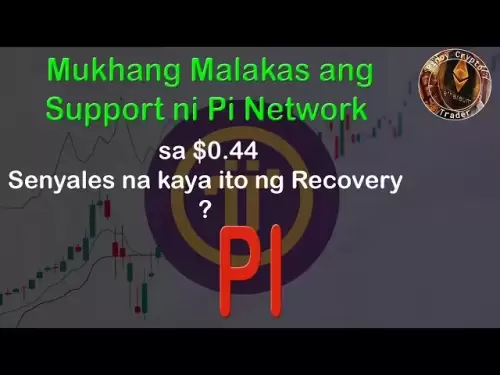-
 Bitcoin
Bitcoin $108,708.8110
0.60% -
 Ethereum
Ethereum $2,561.6057
1.91% -
 Tether USDt
Tether USDt $1.0001
-0.03% -
 XRP
XRP $2.2795
0.57% -
 BNB
BNB $662.2393
1.00% -
 Solana
Solana $153.1346
3.74% -
 USDC
USDC $1.0000
0.00% -
 TRON
TRON $0.2877
0.97% -
 Dogecoin
Dogecoin $0.1710
3.93% -
 Cardano
Cardano $0.5871
1.61% -
 Hyperliquid
Hyperliquid $39.6663
1.68% -
 Sui
Sui $2.9032
0.79% -
 Bitcoin Cash
Bitcoin Cash $496.1879
1.71% -
 Chainlink
Chainlink $13.5807
3.01% -
 UNUS SED LEO
UNUS SED LEO $9.0777
0.61% -
 Stellar
Stellar $0.2514
4.51% -
 Avalanche
Avalanche $18.1761
1.86% -
 Shiba Inu
Shiba Inu $0.0...01173
1.72% -
 Toncoin
Toncoin $2.8010
-4.23% -
 Hedera
Hedera $0.1594
3.21% -
 Litecoin
Litecoin $87.0257
-0.53% -
 Monero
Monero $319.1217
1.79% -
 Polkadot
Polkadot $3.3853
0.68% -
 Dai
Dai $0.9999
-0.01% -
 Ethena USDe
Ethena USDe $1.0003
0.02% -
 Bitget Token
Bitget Token $4.3420
-0.97% -
 Uniswap
Uniswap $7.3772
1.39% -
 Aave
Aave $286.6277
5.61% -
 Pepe
Pepe $0.0...09994
2.33% -
 Pi
Pi $0.4589
1.76%
How to Convert EOS to USDC on Binance
Converting EOS to USDC on Binance involves setting up an account, depositing EOS, trading it for USDC, and optionally withdrawing USDC, all while monitoring fees and transaction status.
Apr 16, 2025 at 12:35 pm

Converting EOS to USDC on Binance is a straightforward process that involves a few key steps. Binance, being one of the largest cryptocurrency exchanges, offers a user-friendly platform that makes it easy to swap one cryptocurrency for another. In this guide, we will walk you through the detailed process of converting EOS to USDC on Binance, ensuring you understand each step thoroughly.
Preparing Your Binance Account
Before you can convert EOS to USDC, you need to ensure that your Binance account is set up and ready to go. If you don't have an account yet, you'll need to register on the Binance website. Here’s how to get started:
- Visit the Binance website and click on the "Register" button.
- Enter your email address and create a strong password.
- Complete the verification process by entering the code sent to your email.
- Enable two-factor authentication (2FA) for added security.
Once your account is set up, you'll need to deposit EOS into your Binance wallet. Navigate to the "Wallet" section, select "Deposit," and choose EOS from the list of available cryptocurrencies. Follow the instructions to deposit your EOS.
Navigating to the Trading Section
After your EOS is successfully deposited into your Binance account, you'll need to navigate to the trading section to convert it to USDC. Here's how to do that:
- Click on the "Trade" button at the top of the Binance homepage.
- Select "Basic" or "Advanced" trading, depending on your preference. For beginners, the "Basic" interface is usually more straightforward.
- In the search bar, type "EOS" and select the EOS/USDC trading pair.
Executing the Trade
Now that you're in the trading section with the correct trading pair selected, you can execute the trade to convert your EOS to USDC. Here are the steps to follow:
- Check the current market price of EOS in USDC.
- Enter the amount of EOS you wish to convert in the "Amount" field.
- Review the total USDC you will receive after the conversion.
- Click on the "Buy USDC" button to execute the trade.
Once the trade is executed, the USDC will be credited to your Binance wallet.
Withdrawing USDC
If you want to move your USDC out of Binance to another wallet or exchange, you'll need to withdraw it. Here’s how to do that:
- Navigate to the "Wallet" section and select "Withdraw."
- Choose USDC from the list of available cryptocurrencies.
- Enter the address of the wallet where you want to send the USDC.
- Enter the amount of USDC you wish to withdraw.
- Review the transaction details and click on "Submit."
Make sure to double-check the withdrawal address to avoid sending your USDC to the wrong place.
Understanding Fees and Limits
It's important to be aware of the fees and limits associated with trading and withdrawing on Binance. Here’s what you need to know:
- Trading fees on Binance vary depending on your trading volume and whether you use the Basic or Advanced trading interface. Typically, fees range from 0.1% to 0.02%.
- Withdrawal fees for USDC are usually minimal but can vary. You can check the current withdrawal fee for USDC on the Binance fee page.
- Withdrawal limits may apply, depending on your account level and verification status. Higher verification levels often allow for larger withdrawal limits.
Always check the latest fee structure and limits on the Binance website before executing any trades or withdrawals.
Monitoring Your Transactions
After converting your EOS to USDC and possibly withdrawing it, it's a good practice to monitor your transactions. Here’s how to do that:
- Go to the "Orders" section to see the status of your recent trades.
- Check the "Transaction History" in the "Wallet" section to view your deposits, withdrawals, and trades.
- Use the "Trade History" tab in the trading interface to review past trades and analyze your trading performance.
Regular monitoring helps ensure that all your transactions are processed correctly and allows you to keep track of your cryptocurrency portfolio.
Frequently Asked Questions
Q: Can I convert EOS to USDC on other exchanges besides Binance?
A: Yes, you can convert EOS to USDC on other exchanges that support both cryptocurrencies. Popular alternatives include Coinbase, Kraken, and Huobi. The process may vary slightly depending on the platform, but the general steps are similar to those on Binance.
Q: What should I do if my EOS to USDC conversion fails?
A: If your conversion fails, first check the status of your order in the "Orders" section. If the order is still pending, wait a bit longer as it may take some time to process. If it shows as canceled or failed, ensure you have sufficient EOS in your wallet and that you entered the correct amount. You can also contact Binance support for further assistance.
Q: Is it possible to convert EOS to USDC directly from a hardware wallet?
A: No, you cannot convert EOS to USDC directly from a hardware wallet. You'll need to transfer your EOS to an exchange like Binance first, then convert it to USDC, and finally, if desired, withdraw the USDC back to your hardware wallet.
Q: How long does it take to convert EOS to USDC on Binance?
A: The conversion itself is usually instantaneous, but the time it takes for the USDC to appear in your wallet can vary. Typically, it should be credited within a few minutes. If you're withdrawing USDC to an external wallet, the process can take anywhere from a few minutes to several hours, depending on the blockchain's congestion and the speed of the network.
Disclaimer:info@kdj.com
The information provided is not trading advice. kdj.com does not assume any responsibility for any investments made based on the information provided in this article. Cryptocurrencies are highly volatile and it is highly recommended that you invest with caution after thorough research!
If you believe that the content used on this website infringes your copyright, please contact us immediately (info@kdj.com) and we will delete it promptly.
- Bitcoin Wallet Hack? Coinbase Exec Sounds the Alarm on $8B Whale Movement
- 2025-07-07 18:30:12
- Mercado Bitcoin, Tokenization, and XRP Ledger: A Latin American Power Play
- 2025-07-07 18:30:12
- XYZVerse, Wall Street, and the Crypto Upswing: What's the Deal?
- 2025-07-07 19:10:12
- AI, Web3, and Communities: Building the Future Together
- 2025-07-07 19:10:12
- AurealOne: A Promising Early-Stage Metaverse Project
- 2025-07-07 19:15:12
- Dogecoin Price: Crypto Market Analysis and the Musk Effect
- 2025-07-07 19:50:12
Related knowledge
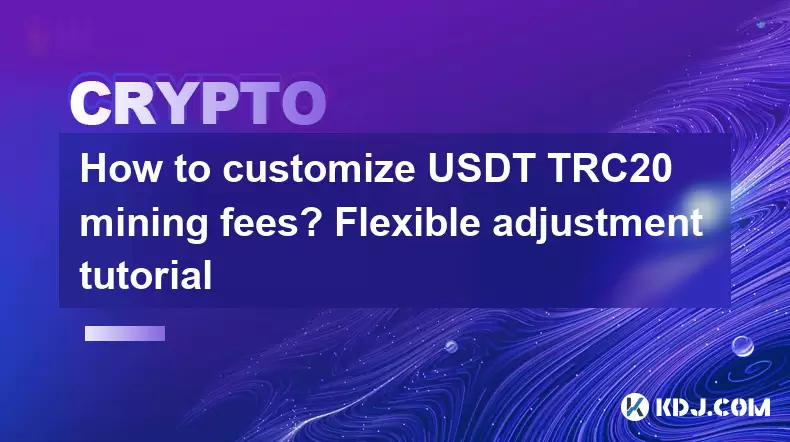
How to customize USDT TRC20 mining fees? Flexible adjustment tutorial
Jun 13,2025 at 01:42am
Understanding USDT TRC20 Mining FeesMining fees on the TRON (TRC20) network are essential for processing transactions. Unlike Bitcoin or Ethereum, where miners directly validate transactions, TRON uses a delegated proof-of-stake (DPoS) mechanism. However, users still need to pay bandwidth and energy fees, which are collectively referred to as 'mining fe...
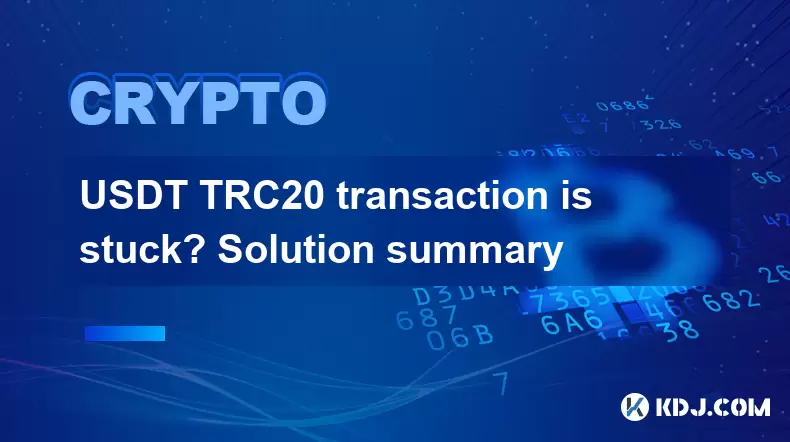
USDT TRC20 transaction is stuck? Solution summary
Jun 14,2025 at 11:15pm
Understanding USDT TRC20 TransactionsWhen users mention that a USDT TRC20 transaction is stuck, they typically refer to a situation where the transfer of Tether (USDT) on the TRON blockchain has not been confirmed for an extended period. This issue may arise due to various reasons such as network congestion, insufficient transaction fees, or wallet-rela...
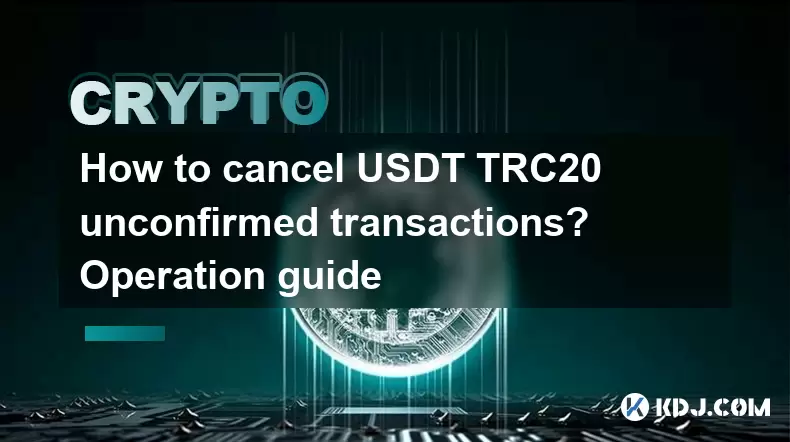
How to cancel USDT TRC20 unconfirmed transactions? Operation guide
Jun 13,2025 at 11:01pm
Understanding USDT TRC20 Unconfirmed TransactionsWhen dealing with USDT TRC20 transactions, it’s crucial to understand what an unconfirmed transaction means. An unconfirmed transaction is one that has been broadcasted to the blockchain network but hasn’t yet been included in a block. This typically occurs due to low transaction fees or network congestio...
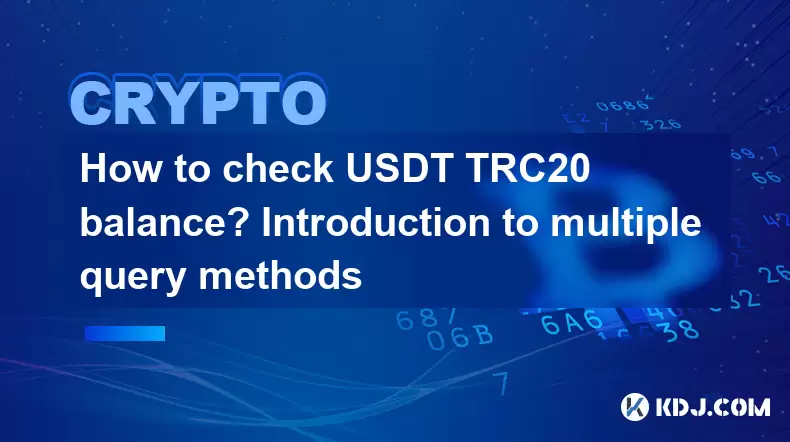
How to check USDT TRC20 balance? Introduction to multiple query methods
Jun 21,2025 at 02:42am
Understanding USDT TRC20 and Its ImportanceUSDT (Tether) is one of the most widely used stablecoins in the cryptocurrency market. It exists on multiple blockchain networks, including TRC20, which operates on the Tron (TRX) network. Checking your USDT TRC20 balance accurately is crucial for users who hold or transact with this asset. Whether you're sendi...
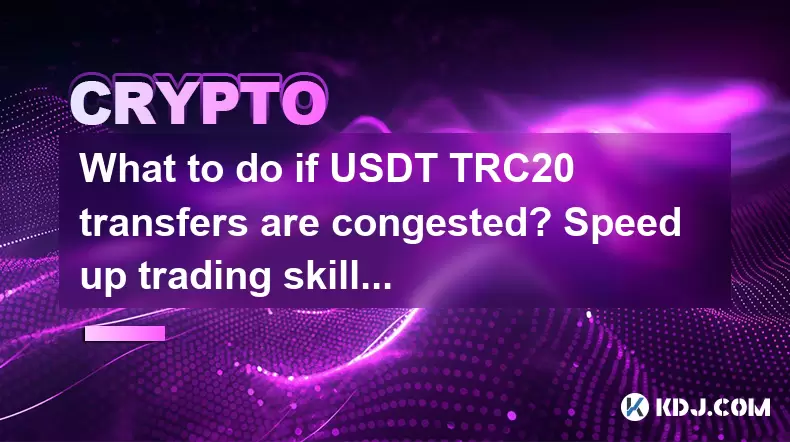
What to do if USDT TRC20 transfers are congested? Speed up trading skills
Jun 13,2025 at 09:56am
Understanding USDT TRC20 Transfer CongestionWhen transferring USDT TRC20, users may occasionally experience delays or congestion. This typically occurs due to network overload on the TRON blockchain, which hosts the TRC20 version of Tether. Unlike the ERC20 variant (which runs on Ethereum), TRC20 transactions are generally faster and cheaper, but during...
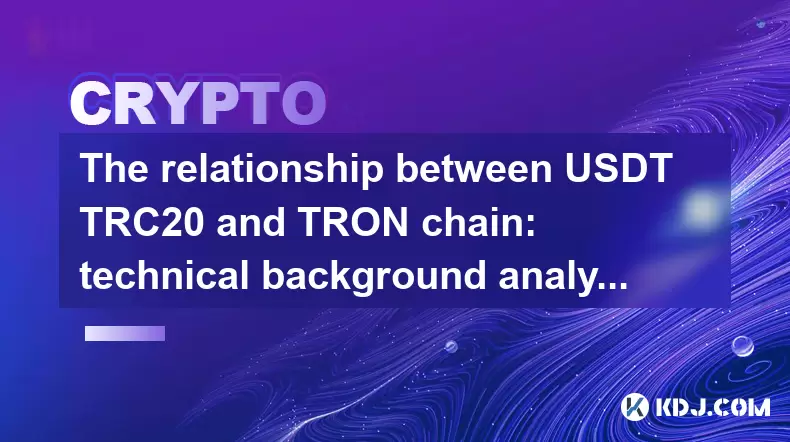
The relationship between USDT TRC20 and TRON chain: technical background analysis
Jun 12,2025 at 01:28pm
What is USDT TRC20?USDT TRC20 refers to the Tether (USDT) token issued on the TRON blockchain using the TRC-20 standard. Unlike the more commonly known ERC-20 version of USDT (which runs on Ethereum), the TRC-20 variant leverages the TRON network's infrastructure for faster and cheaper transactions. The emergence of this version came as part of Tether’s...

How to customize USDT TRC20 mining fees? Flexible adjustment tutorial
Jun 13,2025 at 01:42am
Understanding USDT TRC20 Mining FeesMining fees on the TRON (TRC20) network are essential for processing transactions. Unlike Bitcoin or Ethereum, where miners directly validate transactions, TRON uses a delegated proof-of-stake (DPoS) mechanism. However, users still need to pay bandwidth and energy fees, which are collectively referred to as 'mining fe...

USDT TRC20 transaction is stuck? Solution summary
Jun 14,2025 at 11:15pm
Understanding USDT TRC20 TransactionsWhen users mention that a USDT TRC20 transaction is stuck, they typically refer to a situation where the transfer of Tether (USDT) on the TRON blockchain has not been confirmed for an extended period. This issue may arise due to various reasons such as network congestion, insufficient transaction fees, or wallet-rela...

How to cancel USDT TRC20 unconfirmed transactions? Operation guide
Jun 13,2025 at 11:01pm
Understanding USDT TRC20 Unconfirmed TransactionsWhen dealing with USDT TRC20 transactions, it’s crucial to understand what an unconfirmed transaction means. An unconfirmed transaction is one that has been broadcasted to the blockchain network but hasn’t yet been included in a block. This typically occurs due to low transaction fees or network congestio...

How to check USDT TRC20 balance? Introduction to multiple query methods
Jun 21,2025 at 02:42am
Understanding USDT TRC20 and Its ImportanceUSDT (Tether) is one of the most widely used stablecoins in the cryptocurrency market. It exists on multiple blockchain networks, including TRC20, which operates on the Tron (TRX) network. Checking your USDT TRC20 balance accurately is crucial for users who hold or transact with this asset. Whether you're sendi...

What to do if USDT TRC20 transfers are congested? Speed up trading skills
Jun 13,2025 at 09:56am
Understanding USDT TRC20 Transfer CongestionWhen transferring USDT TRC20, users may occasionally experience delays or congestion. This typically occurs due to network overload on the TRON blockchain, which hosts the TRC20 version of Tether. Unlike the ERC20 variant (which runs on Ethereum), TRC20 transactions are generally faster and cheaper, but during...

The relationship between USDT TRC20 and TRON chain: technical background analysis
Jun 12,2025 at 01:28pm
What is USDT TRC20?USDT TRC20 refers to the Tether (USDT) token issued on the TRON blockchain using the TRC-20 standard. Unlike the more commonly known ERC-20 version of USDT (which runs on Ethereum), the TRC-20 variant leverages the TRON network's infrastructure for faster and cheaper transactions. The emergence of this version came as part of Tether’s...
See all articles























